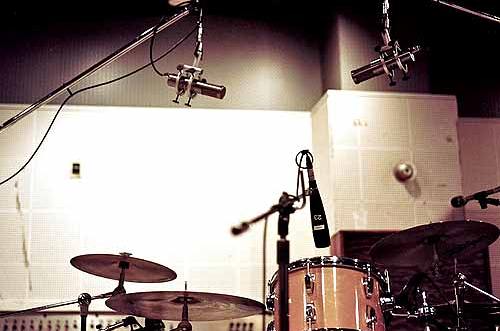A pair of overhead condenser mics is arguably the most important component of this set-up, giving you an overall picture of your entire kit’s sound. Condenser microphones that use a cardiod pattern are the best option when it comes to overhead drum mics. Not only will investing in a high-quality matched pair of condenser mics vastly improve your drum set-up, but these versatile microphones work just as well for vocalists and acoustic instrumentalists, making them a must-have component of your recording arsenal.
Below are our recommendations fro the 4 best overhead drum mics on the market:
Best Overhead Drum Mics 1: AKG Pro C414
Though it’s marketed as a microphone for vocalists and soloists, the characteristics of this mic that make it great for those applications also make it a perfect overhead drum microphone. It’s a large diaphragm condenser microphone (see full specs) that has nine different polar patterns, making it customizable for a variety of applications. This makes it a perfect addition to any recording studio’s arsenal and gives you a lot of flexibility in regards to how you capture sound.
It’s an improvement over AKG’s similar past models, boosting the presence and spatial reproduction that make it perfect for overhead miking. The broad dynamic range captures all the nuance of your kit, while the bass filters help to clarify and clean up the percussion sound in your mix.
Best Overhead Drum Mics 2: AKG Pro Audio C214
Another excellent option from AKG is their C214 model, one of the few entries in their catalogue that lets you get a matched pair for a moderately affordable price. Like the C414 above, it uses the patented AKG dual-capsule system and Back-Plate technology in a large-diaphragm condenser mic, though with just one pattern (cardiod) that’s perfect for overhead drum mics. It strikes an excellent balance between sensitivity and durability, able to handle the sharp attacks and dynamics of a drum kit without missing any of the nuanced details. It also has some tone-shaping features, including a low-cut switch, 20dB attenuation pad, and a 13dB noise floor. It’s among the best overhead drum mics period.
Best Overhead Drum Mics 3: Neumann SKM 184
This matched pair of small-diaphragm condenser mics uses a cardiod pattern to capture just the sound of your kit and none of the extraneous noise of the room that other patterns tend to pick up. It gives you a noise-free operation and an incredibly accurate sound capture with a tone that’s crisp but doesn’t neglect the mid- and low-range of the spectrum. As an overhead drum mic, this means the SKM 184 can handle the whole range of a kit, from the boom of the kick drum to the shimmer of a splash cymbal, keeping the whole sonic picture balanced in the mix. Just check out the video below. It’s for the KM 184:
Best Overhead Drum Mics 4: Shure KSM 141
Another option for the sound engineer on a budget is the Shure KSM 141, which offers professional miking technology and two choices of polar patterns (cardiod or omnidirectional) for a great price. It brings you all the features of pricier condenser mics, including a subsonic filter that eliminates self-noise and a three-position switchable pad that’s great for the high sound pressure levels involved in miking a drum kit.
The adjustable low-pass filter gives you three settings so you can tailor the frequency capture to the equipment in the kit, while the low-mass Mylar diaphragm gives you an incredibly detailed response with a lot of flexibility. This just might be the best overhead drum mics for the money.
Overhead Drum Mics: Why Condenser Mics?
There are three basic types of microphone: dynamic, condenser, and ribbon. Ribbon microphones are the most specialized of these, generating the signal by conducting electricity through a ribbon suspended between two magnetic poles. They have a figure-8 or bi-directional polar pattern and are typically delicate, warping easily when used to record high dynamics or sharp sounds, and are typically a poor choice for percussion.
Dynamic mics, on the other end of the spectrum, use a coil attached to a diaphragm that moves through a magnetic field. This style is more durable when it comes to high sound pressure levels; since they can handle a lot of abuse, they’re great for close-miking of kick or snare drums, but don’t give you as much fine detail or sensitivity.
Condenser mics are perfect overhead drum mics because they strike a balance between the durability of a dynamic mic and the sensitivity of a ribbon mic. They’re designed with two conductive plates, one of which is charged, allowing a signal to be generated when the other plate moves across it. This gives condenser microphones a wider frequency response and higher sensitivity than dynamic microphones. Though they can’t handle high sound pressure levels from close-miking of drums, the distance of an overhead set-up is enough to protect the microphone while still capturing the detail of a multi-piece kit.
Overhead Drum Mics: Diaphragm Size Recommendations
Condenser mics come in large and small diaphragm versions. Traditionally, a large diaphragm microphone has a membrane of 1” or greater in diameter, while a small diaphragm’s membrane has a diameter of ½” or smaller. These size restrictions aren’t as cut and dry in modern microphones. Despite the name, it’s not really the size of the diaphragm that matters when you’re comparing small diaphragm vs large diaphragm condenser microphones.
The large diaphragm condenser was pioneered back in the 1930s. It was designed to combat high-noise equipment. The larger diaphragm generated a higher signal voltage, and this meant it could capture sound even with a lot of interference.
As audio recording equipment improved and got less noisy, small-diaphragm condenser mics gained popularity. As microphones go, they’re generally better. They can capture a wider range of frequencies, with an especially improved performance in the high end. They also have a more consistent response and pickup pattern for a cleaner, truer sound capture.
The main advantage of a large-diaphragm mic is that it has a low self-noise. You won’t get a lot of signal interference, so they’re a good option if you want high transparency. They also maintain their signal integrity well when the source of the sound is in motion, like is the case with many live musicians.
Speaking specifically to drums, most people prefer small diaphragm condensers as overhead mics because they’re better at capturing the pure sound and complex detail of a drum kit. Large-diaphragm condensers do have a place in a drum mic set-up, but they’re typically reserved for the kick drum or toms.








